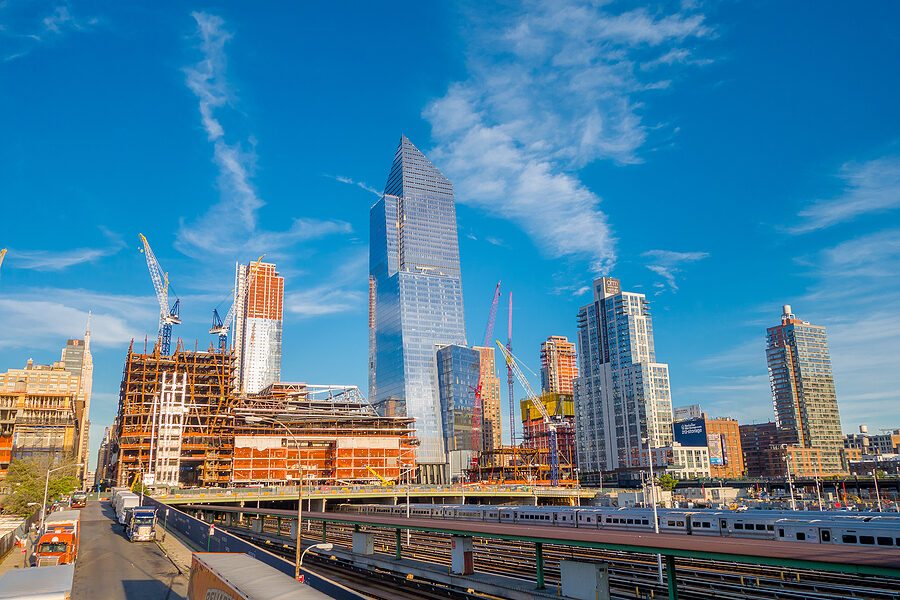2021 Forecast: Building for the Future
By Frank Fortino
As we welcome a new year, we also take time to pause and reflect on the previous 12 months. One year ago, no one could have predicted the events that lay ahead, courtesy of the COVID-19 pandemic. Forecasts of a banner year for our industry crumbled as all but essential construction projects stopped during the spring. Despite this significant setback, 2020 construction spending is expected to exceed the spending from eight of the past 10 years, according to the 2020 – 2022 New York City Construction Outlook, published by the New York Building Congress.
The latest edition of this benchmark publication, based on a series of economic indicators and assumptions, predicts a strong forecast for the next three years—even though construction activity promises to look very different than previously anticipated.
Construction Spending & Employment
The Building Congress forecasts total construction spending of $55.5 billion across the five boroughs. This number represents a decrease of 8.5% versus 2019 spending but matches the 2017 level, which set a record at that time. Total spending is expected to remain relatively flat over the next two years, increasing to $56.9 billion in 2021 and slipping to $56.1 billion in 2022. During this forecast period, residential spending will continue to decrease, while non-residential and government spending will grow.
Given the anticipated reduction in total spending, the number of construction jobs in New York City is expected to fall to 128,200 in 2020, slightly lower than 2014 levels. Employment is expected to recover over the next two years, with 136,650 and 140,200 jobs in 2021 and 2022, respectively. Average employment for these three years would represent a 14% decrease over the previous three-year period.
Reduced Residential Construction
For 2020, the Building Congress predicts $17.8 billion in residential construction spending, which includes both new construction and alterations to existing buildings. While this figure represents a significant drop from the 2019 peak of $19.7 billion, it actually exceeds last year’s forecast of $17.6. Moving forward, however, sector activity will likely decline, with forecasted spending of $14.3 billion in 2021 and $12.5 billion in 2022—placing average spending during this period on par with spending between 2014 and 2018.
Combined, residential construction should add 50,450 new housing units—20,450 units in 2020, followed by 15,000 units in each of the following years. Residential activity should add 44.6 million square feet of residential floor space in 2020, 39 million in 2021, and 33 million in 2022. When compared to 2017-2019, the forecasted period will likely contribute 33% fewer new housing units and 14% less in constructed floor space.
Non-Residential Explosion
While non-residential construction spending should reach $16.6 billion in 2020, the Building Congress forecasts that spending will recover over the next two years. Total sector spending is expected to increase to $19.5 billion in 2021 and $21.8 billion in 2022, surpassing the 2019 record of $21.2 billion. This activity should create record-high levels of new non-residential floorspace: 53.3 million square feet in 2020, 59.4 million in 2021, and 63 million in 2022—a 59% increase over the previous three-year period.
Construction activity will likely reflect the impact of the pandemic, with some areas surging, and others declining. Office construction, which typically comprises half of non-residential spending, is expected to increase in 2021, fueled by interior renovations designed to reduce the spread of COVID-19. Core-and-shell construction is expected to decline, with some new office starts delayed into 2023 and 2024. Hard-hit industries, including retail, entertainment, and hotels, will see less activity, while construction related to warehousing and logistics may increase to support the shift toward e-commerce.
The Building Congress anticipates that the healthcare industry will lead institutional projects. Spending in healthcare construction should exceed $9.4 billion between 2020 and 2023, a 38% increase from 2016-2019.
Increased Government Investment
Government construction should reach $21.1 billion in 2020, compared to $19.7 in 2019. The Building Congress expects spending to reach $23.1 billion in 2021 before leveling out at $21.9 billion the following year. During this time, government construction should account for nearly 40% of total construction spending, representing 31% growth compared to 2017-2019. The Metropolitan Transportation Authority and the Port Authority of New York and New Jersey are both expected to increase their spending over the next three years, although much depends on the amount of federal aid received to offset pandemic-related shortfalls.
A Testament to Resiliency
Once again, the observations and models in the annual Construction Outlook mirror what we have a company have seen since New York State lifted the non-essential construction ban. After a slow reboot, construction activity has steadily gained steam throughout the five boroughs. We commend the Department of Buildings and other municipal agencies for their rapid pivot to online applications and for their continued commitment to serving this industry, which represents a critical economic engine in New York City.
The construction landscape looks very different than it did one year ago, and projects are shifting to reflect the new reality. All in all, as we continue to face the challenge of an ongoing pandemic, we have much to be thankful for and many reasons to be optimistic about the year ahead. We look forward to partnering with you in 2021 to build a better city for all New Yorkers.


